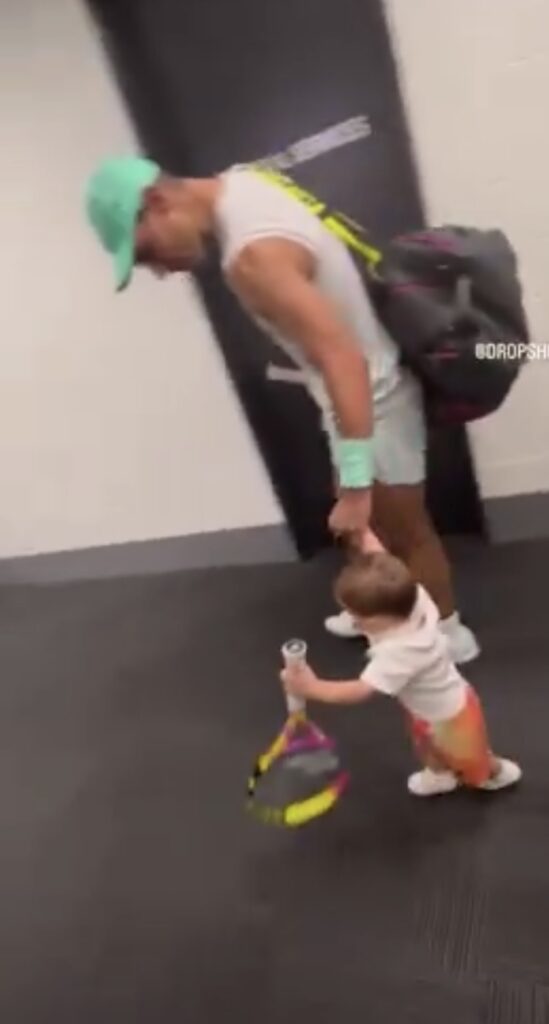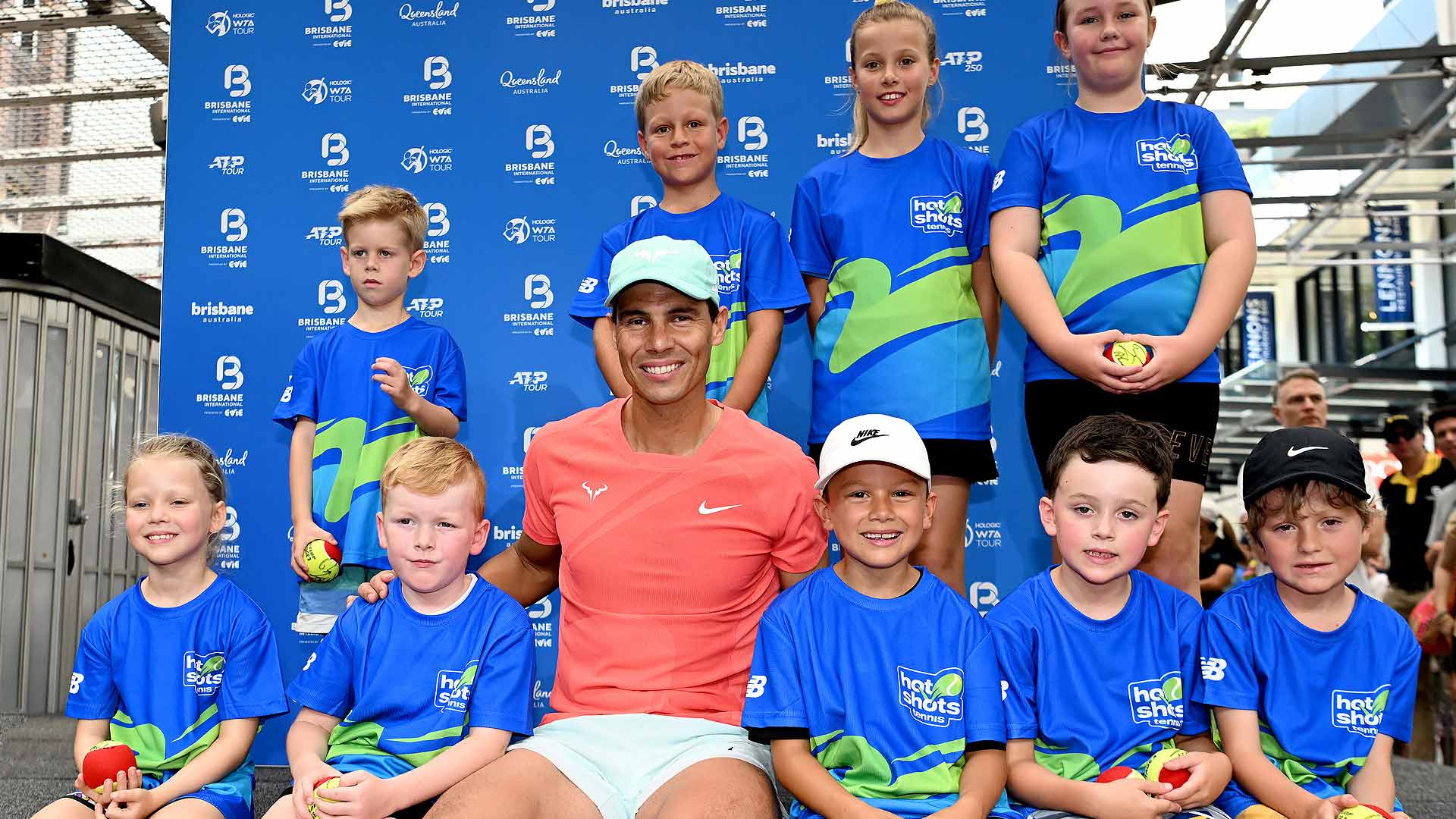When Rafael Nadal, racket in hand, appears walking through the Brisbane tournament holding Rafael Nadal’s hand, racket in hand, the same question that has been asked so many times comes up again.
How is this possible?
Brisbane is the first stop on Nadal’s uncertain return to tennis after a year’s break and regeneration through injury, but to see Rafael Nadal Parera holding hands with Rafael Nadal Perelló, barely 15 months old, dressed as a tennis player and, yes, racket in hand, is a hymn to hope.
A hope that Nadal takes with caution, although he has it. “When I get to Paris I’ll know if it’s my last year,” the former world number one told journalist Manuel Jabois in an interview for “El País Semanal”, the Sunday magazine of the Spanish newspaper “El País”. Austrian Dominic Thiem, on Tuesday 2 January, is his first hurdle in Brisbane.
The interview was conducted on 13 December at the “Rafael Nadal Tennis Academy” in Kuwait, but includes a scoop: the Spaniard, who will turn 38 on June 3rd, will announce before Roland Garros whether or not 2024 is the last year of his career.
“There will be an announcement beforehand. It will have been five months of margin in the circuit and I will know my reality: one can intuit these things, but until you do not feel them you can not do anything. I am prepared. I’m aware that it’s very likely that it’s going to be my last year. I’d love to be able to say “I’m leaving” before Australia, that it’s going to be my last year and that it’s going to be known, to play with the emotion of saying goodbye and for the public to experience the games in a different way.
But he won’t. Why not? For the same reason he developed in May 2023, in that dramatic press conference in Manacor in which he announced a full stop.

“I have seen mates who have announced these things and, four years later, they are still playing. Well, I don’t like it (…). I am aware that there are many options for it to end, but I don’t know one hundred percent. If suddenly at the end of the year I feel good physically, my family is doing well with what I do, I have fun and I feel competitive? But as I know that this is very difficult, I am preparing myself for the goodbye.”
It is, as so often throughout Nadal’s career, a yes, but no. Or no, but yes.
The interview with Nadal by Jabois, one of the great names in Spanish journalism, is generous in interesting definitions. An example? The explanation to defend the tennis of long points, of extensive exchanges.
“Extraordinary points are always accompanied by rallies. It is very difficult, from my own experience, to excite the spectator with points of two or three strokes. No matter how spectacular it is. The spectator gets into the match, gets excited and gets involved, and we perceive that on the court when the match is long and there are long points. When there is drama. And that only comes from the rallies.”
Another one? The explanation of why tennis can’t be taken as a job: “I’m more of a competitor than a winner, to be honest. Defeat doesn’t destroy me. There are matches that it hurts to lose, it would only be wrong. But I’m more of a competitor. If I compete, I feel good. Sport can’t be a job that you go to just to do what you have to do. There has to be illusion, madness, flame.”
A defeat that hurt you? “I was very frustrated to lose the Australia 2014 final against (Stanislas) Wawrinka. I was broken: I injured my back in the first set. That really sunk me. I was really hurt for a long time. Why? Because I couldn’t even compete.”
The journalist reminds him of Novak Djokovic’s statements in which the Serb claims to have felt intimidated by the jumps and snorts of Nadal in the locker room before matches. Nadal rejects that idea: “Never, never, never was my intention. I warm up like that, I try to be prepared and ready to go, and I work out, nothing else.”
And, 672 of the ranking today, but with mentality of number one, speaks of Roger Federer, his great symbolic rival, the man around which he built his career.
“Federer was perfection at the aesthetic level, at the level of elegance, at the technical level. I have very good technique, a lot, but technique is not the same as aesthetics. They are two different things. He had an incredible technique, making things very beautiful with an impressive elegance. When I arrived, he was number one in the world, and he got an opponent with long hair and an exuberant physique. Elegance against a warrior. There was a combination of personalities and styles; and that, together with the fact that we played a lot of matches on the most important stages, turned our rivalry into something that transcended more than any other duel.”
Nadal’s analysis, defining himself as a “warrior” and owner of “an exuberant physique” is novel in those terms. And it is also interesting what he says about the “new Federer”, the one who returned in 2017 to win the Australian Open twice and Wimbledon once: “When he came back in 2017, after his injury, he made a very important change. He changes the racquet for a bigger racquet, which hits harder, and he makes a mental change. Because he knows he can’t run like before, he becomes a much more aggressive player, and it hurts me a lot. He was a better player than me on hard court, but up to that point I think I had beaten him more often there.”
“But he reinvents himself, and he puts another twist on his game: hyper-aggressive. My tactic of punishing his backhand still worked, but it doesn’t have as much effect because he doesn’t let me: he plays too fast. He didn’t allow me to repeat my repetition against his weak point.”
And then Nadal also leaves a novel idea, the explanation of Federer’s mistake: “It’s something he had made a mistake with in his career: he let me repeat the shots to his backhand. His exit was a cut backhand, and I have a very good ball when I cut it, it does not bother me, I like to return it and I return it strong, I am not uncomfortable”.
Saved that error, Federer is, more than a year after retiring, something too big for Nadal: “Since I can remember he is the player who has impressed me the most, the one who has amused me the most, the one who has excited me the most. I’ve been more excited to see Federer play than Djokovic, and in the end tennis is emotion, emotion is what drags you to him.”









